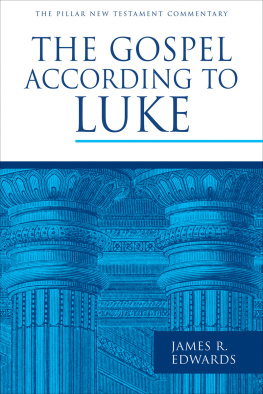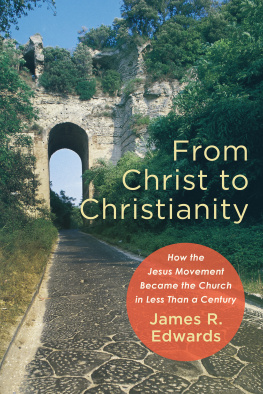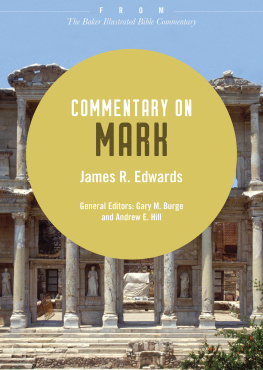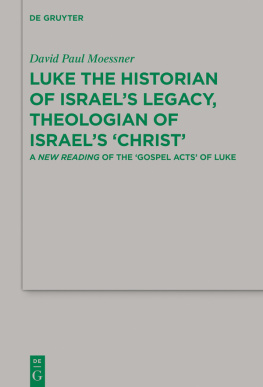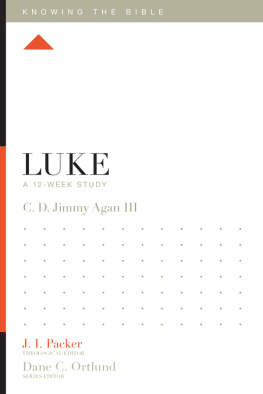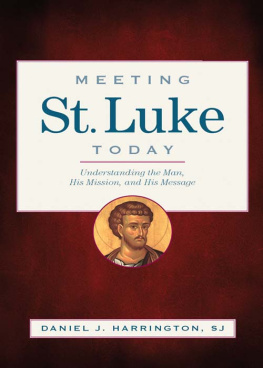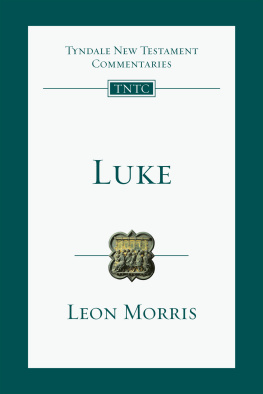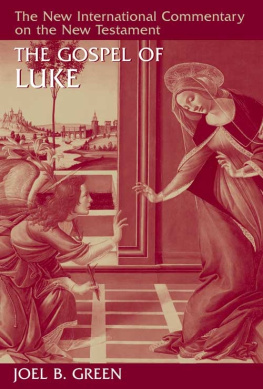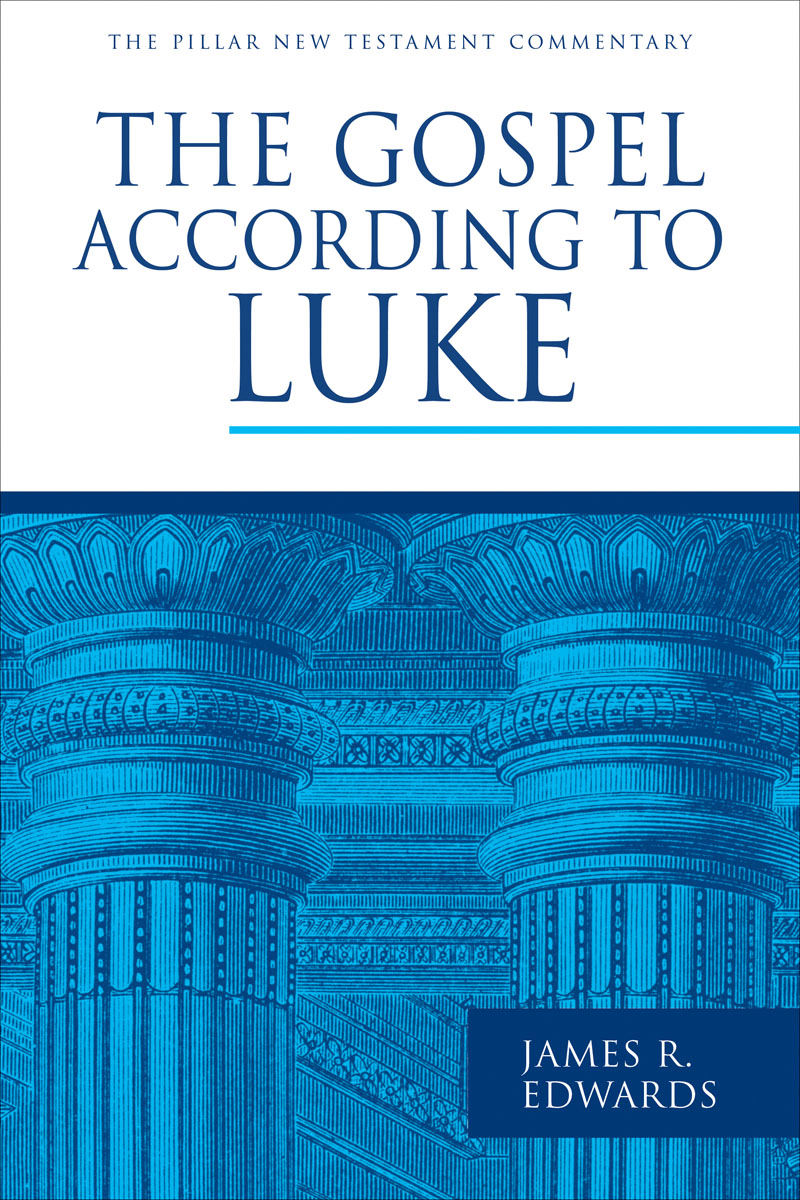
T HE P ILLAR N EW T ESTAMENT C OMMENTARY
General Editor
D. A. CARSON
2015 James R. Edwards
All rights reserved
Published 2015 in the United States of America by
Wm. B. Eerdmans Publishing Co.
2140 Oak Industrial Drive N.E., Grand Rapids, Michigan 49505 /
P.O. Box 163, Cambridge CB3 9PU U.K.
www.eerdmans.com
and in the United Kingdom by
APOLLOS
Norton Street, Nottingham,
England NG7 3HR
Printed in the United States of America
21 20 19 18 17 16 15 7 6 5 4 3 2 1
Library of Congress Cataloging-in-Publication Data
Edwards, James R.
The gospel according to Luke / James R. Edwards.
pages cm.(The Pillar New Testament commentary)
ISBN 978-0-8028-3735-6 (cloth: alk. paper)
1. Bible. LukeCommentaries. I. Title.
BS2595.53.E39 2015
226.407dc23
2014043605
British Library Cataloguing in Publication Data
A catalogue record for this book is available from the British Library.
ISBN 978-1-78359-268-5
To my family
Contents
Editors Preface
Commentaries have specific aims, and this series is no exception. Designed for serious pastors and teachers of the Bible, the Pillar commentaries seek above all to make clear the text of Scripture as we have it. The scholars writing these volumes interact with the most important informed contemporary debate, but avoid getting mired in undue technical detail. Their ideal is a blend of rigorous exegesis and exposition, with an eye alert both to biblical theology and to the contemporary relevance of the Bible, without confusing the commentary and the sermon.
The rationale for this approach is that the vision of objective scholarship (a vain chimera) may actually be profane. God stands over against us; we do not stand in judgment of him. When God speaks to us through his Word, those who profess to know him must respond in an appropriate way, and that is certainly different from a stance in which the scholar projects an image of autonomous distance. Yet this is no surreptitious appeal for uncontrolled subjectivity. The writers of this series aim for an even-handed openness to the text that is the best kind of objectivity of all.
If the text is Gods Word, it is appropriate that we respond with reverence, a certain fear, a holy joy, a questing obedience. These values should be reflected in the way Christians write. With these values in place, the Pillar commentaries will be warmly welcomed not only by pastors, teachers, and students, but by general readers as well.

The challenges associated with writing a good commentary on one of the canonical Gospels are well known. I briefly articulated a handful of them in the Preface to James Edwardss excellent commentary on Mark (also in the Pillar series). By adding this commentary on Luke, Dr. Edwards has successfully navigated two further challenges: first, he has ensured that Luke speaks in his own voice, and not merely as a slightly-longer-Mark; and second, he has not forgotten that Lukes Gospel is the first volume of a two-volume work, such that one must be aware of Lukes companion volume, the Acts of the Apostles, lurking just around the corner. Above all, this commentary carefully explores Lukes witness to Jesus, never losing sight of the fact that whatever we may reasonably infer about Luke himself, or his readers, Lukes first aim is to talk about Jesus. Again and again Dr. Edwards displays a sure-footed exegesis that helps readers grapple with the text of Scripture, simultaneously engendering deepening knowledge and grateful reverence.
D. A. C ARSON
Authors Preface
It is my hope that this commentary will be for church, academy, and personal reading a window of understanding and insight into the Third Gospel. The following practical information will assist readers in a profitable use of the work as a whole. I have followed The SBL Handbook of Style in matters relating to bibliographic formatting and abbreviations of source works, both ancient and modern. Readers will find a complete list of all abbreviations used in the commentary, beginning on p. xii. A list of Frequently Cited Works beginning on p. xxiv provides full bibliographies of works referenced occasionally or regularly in footnotes. When a Frequently Cited Work is referenced, I include the authors last name, a key word from the title in italic print, and page number(s). When a source is cited that is not in the Frequently Cited Works, I include full bibliographical reference. Dates in the Christian era are normally given by year alone (without A.D. or C.E. ), but dates prior to the Christian era are signified by B.C. Scripture references of only chapter and verse (or verse[s] alone) without identifying book refer to Luke; all other Scripture references (including those to Acts) are identified by book, chapter, and verse. In accordance with the editorial policy of the Pillar series, all Scripture citations in the commentary, unless otherwise noted, follow the New International Version (NIV) of the Bible. All English translations of foreign language sources, ancient or modern, are my own, unless otherwise noted. For computer-assisted research I have relied on BibleWorks 7. The commentary on Luke 121 was prepared on the basis of the Greek text of Nestle-Aland, and chaps. 2224 on Nestle-Aland, which became available to me in 2013.
Literature on the NT, as in virtually all fields, has become voluminous, but unlike most other fields, literature on the NT has twenty centuries of momentum behind it. A Gospel commentator stands at the intersection of many exciting fields of knowledge, including archaeology, ancient languages, epigraphy, ancient manuscripts, ancient history and social customs, alertness to the theological intention of an author, and the way the church has understood that theological intention over the ages. The scope of the task is both stimulating and humbling. Regarding the last-mentioned field above, the page constraints of the commentary have dictated that the various ways the text of Luke has been received in the past two millennia, commonly called reception history, be treated cursorily. Readers interested in this aspect of Lukan research will find Franois Bovons three-volume commentary in the Hermeneia Series comprehensive and illuminating.
I am grateful to God for energy and inspiration to write this commentary, and to the assistance of many friends and colleagues in the process of its writing. I wish first of all to thank Don Carson, general editor of the Pillar series, who arranged through somewhat unusual circumstances for me to return to the series and contribute, in addition to the commentary on the Second Gospel, now the commentary on the Third. The superb editorial eye and hand of Craig Noll at Eerdmans have improved the manuscript at countless points. Financial resources available to the Bruner-Welch Chair of Theology, which I occupy, enabled me to hire four competent and industrious Whitworth University students as research assistants. My gratitude and indebtedness to Amy Erickson, Travis Niles, Rachel Toone, and Joshua Mikelson are enduring. My colleagues in the Theology Department, particularly Jerry Sittser, Adam Neder, and Jonathan Moo, have been helpful, encouraging, and forbearing conversation partners in the writing of this commentary. The interest and insights of students in my course on the Gospel of Luke at Whitworth University and of members of the adult Bible class at Whitworth Community Presbyterian Church, where I taught on Luke for several years, have informed and enriched this commentary in delightful and substantive ways.
Next page
